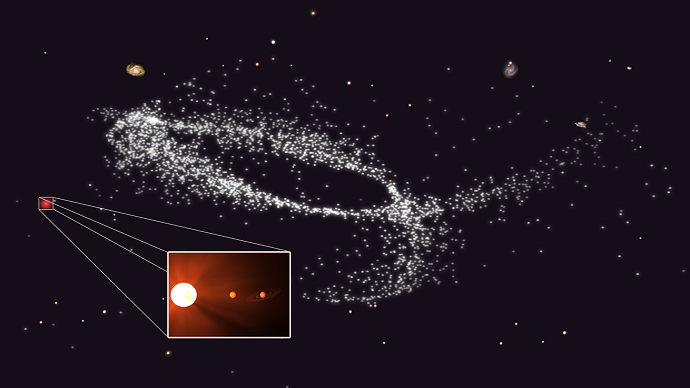4 June 2014
Two new planets orbiting a very old star in our nearby galaxy, known as Kapteyn’s star, are reported in a new study by an international team of astronomers, including researchers from the University of Hertfordshire. One of these planets around Kapteyn’s star could be ripe for life as it orbits at the right distance to allow liquid water on its surface.
Discovered at the end of the 19th century by the Dutch astronomer Jacobus Kapteyn, the star is the second fastest moving one in our sky and belongs to the galactic halo - which is an extended cloud of ancient stars orbiting our Galaxy with very elliptic orbits. With a third of the mass of our Sun, this red-dwarf can be seen in the southern constellation of Pictor with an amateur telescope.
Guillem Anglada-Escude, lead author from Queen Mary University of London, explained: “When we initially analysed the data for Kapteyn’s star a few years ago we found a moderate excess of variability which we did not expect to find in such an old star, so we were on the lookout for planets. Once we had collected enough data the new signals showed up loud and clear.”
The astronomers used new data from the HARPS spectrometer at the ESO's La Silla observatory in Chile to measure tiny periodic changes in the motion of the star. Using the Doppler Effect, which shifts the star’s light spectrum depending on its velocity, the scientists could work out some properties of these planets, such as their masses and orbital periods.
The study also combined data from two other high-precision spectrometers to secure the detection: the HIRES at the Keck Observatory in Hawaii and the PFS at the Magellan Telescope in Chile.
Mikko Tuomi, from the Centre for Astrophysics Research at the University of Hertfordshire added: “The planet known as Kapteyn b has a mass at least five times that of Earth's and orbits the star every 48 days - this is an orbit where it might have liquid water. The second planet, Kapteyn c is a massive super-Earth in comparison. Its year lasts for 121 days and we think it’s too cold to support liquid water.
“At the moment, only a few properties are known for these planets, but by measuring their atmospheres with next-generation instruments which are under construction, we will try to establish whether these planets are water-bearing worlds”.
Typical planetary systems detected by NASA's Kepler mission are hundreds of light-years away. In contrast, Kapteyn's star is the 25th nearest star to the Sun and it is only 13 light years away from Earth.
What makes this discovery different however, is the peculiar story of the star. Kapteyn's star was born in a dwarf galaxy absorbed and disrupted by the early Milky Way. Such galactic disruption event put the star in its fast halo orbit. The likely remnant core of the original dwarf galaxy is omega Centauri, an enigmatic globular cluster 16,000 light years from Earth which contains hundreds of thousands of similarly old suns. This sets the most likely age of the planets at 11.5 billion years; which is 2.5 times older than Earth and 'only' about 2 billion years younger than the Universe itself (around 13.7 billion years).
Dr Anglada-Escude adds: “It does make you wonder what kind of life could have evolved on those planets over such a long time. And so I contacted the science fiction writer Alastair Reynolds who then wrote a short story.”
An extract from the resulting story Sad Kapetyn follows:
Sad Kapteyn, a fictional story by Alastair Reynolds
Hello, Earth. It's me again.
I hope you're receiving my signal loud and clear.
You'll be glad to hear that I've warmed up after the long centuries of my interstellar cruise phase. Having run a complete health check, I can confirm that all aspects of me are performing nominally. Better than nominally, if truth be told. At the risk of boastfulness, I'm actually in excellent shape. Propulsion, AI core, long-range sensors and instrumentation, navigation and communication assemblies - I couldn't be in better condition.
Not bad for a piece of space hardware which has already visited six solar systems, without ever needing to return home. Of course, I can't take credit for myself. I was just well manufactured - built to endure for thousands of years.
All the same, thank you for making me.
Onto business, anyway - and I can't begin to tell you what I've found, out here around Kapteyn's star! This really is an extraordinary place - a solar system unlike any that I've already visited. I wish you could be here with me, seeing things through my eyes."













